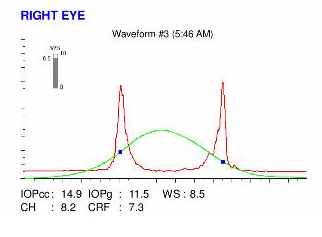The patient

Patient right profile
Bilateral Asymmetric Keratoconus induced by eye rubbing
Identity : Mr G.M
First visit : 06/09/2017
Last Visit : 07/26/2017
Mr G.M is a 50 year old architect who was diagnosed at a late age with keratoconus. He was around 48 years old when the diagnosis was made. He consulted an ophthalmologist initially with the hope of improving his vision which he felt was deteriorating and had not improved with a new spectacle prescription. During his previous follow-up visits, it was explained to him that he had keratoconus which was of late onset, and that it was a genetic disease. No particular emphasis was placed on eye rubbing at that point. The keratoconus was more pronounced in his left eye. He is right handed.
His refraction during the first visit at the Rothschild Foundation (06/09th/2017) was : Right Eye (RE) 20/25 with -0.5 (-0.75 x 80 °) and Left Eye (LE) 20/32 with -1.25 (-1.25 x 130 °).
Clinical examination with the slit lamp revealed an irregular inferior corneal bulge in both eyes .We also found a Fleischer ring (Fleischer rings are pigmented rings in the peripheral cornea, resulting from iron deposition in basal epithelial cells, in the form of hemosiderin) in the left eye.
Systematic corneal topography revealed bilateral keratoconus more pronounced in the left eye.
When first asked about eye rubbing, the patient declared that it did not occur to him that he would particularly rub his eyes, although he would sometimes do it mechanically more as a reflex action. We asked the patient to pay more attention to possible conscious rubbing episodes, and gave him an appointment for a review visit one month later.
During the second visit, the patient acknowledged that he had come to realize that he was rubbing his eyes way more than he had thought, in particular in the shower and at the office in front of the computer screen to relieve ocular fatigue. He described in detail a gesture that he would perform many times a day…After removing his spectacles with his right hand, he would rub both eyes at the same time with the left hand: the thumb would rub the left eye while the index would rub the right eye.
We explained to the patient that since vigorous rubbing had preceded the drop in visual acuity, this habit may have caused the cornea to deform. We strongly advised this patient to stop rubbing his eyes.
Here are pictures of the patient rubbing his eyes and his profiles
 PATIENT RIGHT PROFILE
PATIENT RIGHT PROFILE PATIENT LEFT PROFILE
PATIENT LEFT PROFILE PATIENT RUBBING HIS EYES. The patient demonstrates how he rubs his eyes. At the first visit, he was not aware of having such habit. Note the use of the knuckles, which are particularly detrimental to the globe (toughest part of the hands).
PATIENT RUBBING HIS EYES. The patient demonstrates how he rubs his eyes. At the first visit, he was not aware of having such habit. Note the use of the knuckles, which are particularly detrimental to the globe (toughest part of the hands). THE PATIENT REMOVES HIS GLASSES WITH THE RIGHT HAND AND THEN RUBS HIS EYE WITH THE LEFT HAND
THE PATIENT REMOVES HIS GLASSES WITH THE RIGHT HAND AND THEN RUBS HIS EYE WITH THE LEFT HAND  PATIENT RUBBING HIS EYES WITH THE LEFT HAND. In our experience, the deformation of the cornea is more pronounced when the eye is rubbed with the thumb.
PATIENT RUBBING HIS EYES WITH THE LEFT HAND. In our experience, the deformation of the cornea is more pronounced when the eye is rubbed with the thumb.Here are the Orbscan quadmaps, Pentacam maps, OPDscan (topography and aberrometry) maps and Ocular Response Analyzer (ORA) results of the first visit .
Difference maps were performed at the second visit. No evolution was observed between the first and the last visit. The keratoconus stabilised once the patient became aware of his eye rubbing habit and stopped rubbing his eyes definitively. The next visit is scheduled in three months (early 2018)
Keratoconus is usually diagnosed earlier in life than the fourth decade. In this patient, the keratoconus appeared later in life, and progressed more slowly. He had no allergies during childhood, and only started to work extensively on the computer after the age of 30. This was when he probably developed the habit of eye rubbing, to relieve ocular fatigue. The particular gesture of rubbing the eyes with one hand resulted in a deformation more pronounced in the left eye (rubbed by the thumb). The patient confirmed that while he was rubbing in this manner, he could feel that the left eye was being « more compressed » than the right eye. This explains the discordance between the dominant hand (used to hold the spectacles) and the non-dominant hand rubbing the eyes. We also noticed that people with occupations using their dominant hands to work, such as computer scientists, architects, mechanics etc often use their other non-dominant hand to rub their eyes, and this would coincide with the side with the more severe keratoconus.
In this observation like many others, eye rubbing had preceded the onset of keratoconus by several years.





















